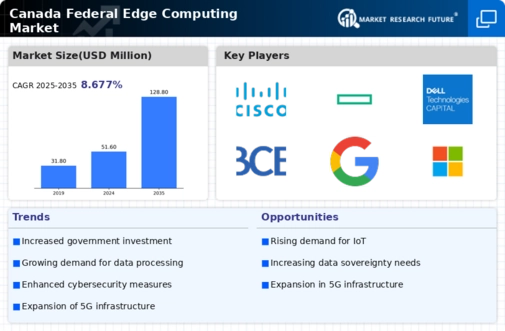Rising Cybersecurity Threats
The increasing prevalence of cybersecurity threats is a significant driver for the federal edge-computing market. As cyberattacks become more sophisticated, Canadian federal agencies are prioritizing the implementation of advanced security measures. Edge computing offers a decentralized approach to data processing, which can enhance security by minimizing the risk of data breaches. The federal edge-computing market is expected to benefit from this trend, as agencies invest in solutions that provide real-time threat detection and response capabilities. According to recent studies, nearly 60% of Canadian organizations have reported experiencing a cyber incident in the past year, highlighting the urgent need for improved cybersecurity measures. Consequently, the rising cybersecurity threats are likely to accelerate the adoption of edge computing technologies within the federal sector, reinforcing the importance of security in the federal edge-computing market.
Enhanced Focus on Data Sovereignty
Data sovereignty has emerged as a critical concern for Canadian federal agencies, driving the federal edge-computing market. With increasing regulations surrounding data privacy and protection, agencies are compelled to ensure that sensitive information remains within national borders. This focus on data sovereignty is likely to lead to a surge in investments in edge computing solutions that facilitate localized data processing. As a result, the federal edge-computing market is projected to grow at a CAGR of around 20% over the next five years. By leveraging edge computing, agencies can maintain compliance with data protection laws while enhancing their operational capabilities. This trend underscores the importance of developing robust edge computing infrastructures that prioritize data sovereignty, ultimately shaping the future landscape of the federal edge-computing market.
Government Initiatives and Funding
Government initiatives and funding are crucial drivers of the federal edge-computing market. The Canadian government has recognized the potential of edge computing to enhance public services and is actively investing in related technologies. Recent funding programs aim to support the development of edge computing infrastructure, which is expected to bolster the capabilities of federal agencies. This commitment is reflected in the allocation of approximately $200 million towards digital transformation initiatives, which include edge computing projects. Such investments are likely to stimulate innovation and encourage collaboration between government entities and technology providers. As a result, government initiatives and funding are anticipated to significantly impact the growth trajectory of the federal edge-computing market, fostering advancements that enhance service delivery and operational efficiency.
Increased Adoption of IoT Technologies
The proliferation of IoT technologies is driving transformation within the federal edge-computing market. Canadian federal agencies are increasingly adopting IoT devices to enhance operational efficiency and service delivery. The integration of IoT with edge computing allows for localized data processing, which is essential for applications such as smart cities and environmental monitoring. This trend is expected to contribute to a market growth rate of approximately 25% over the next few years. By leveraging edge computing, agencies can process data generated by IoT devices in real-time, enabling timely decision-making and improved resource management. The increased adoption of IoT technologies is likely to play a pivotal role in shaping the future of the federal edge-computing market, fostering innovation and enhancing the capabilities of government operations.
Growing Demand for Real-Time Data Processing
The increasing need for real-time data processing is a primary driver in the federal edge-computing market. As government agencies in Canada seek to enhance operational efficiency, the ability to process data at the edge becomes crucial. This demand is reflected in the projected growth of the market, which is expected to reach approximately $1.5 billion by 2026. Real-time analytics enable agencies to make informed decisions swiftly, thereby improving service delivery. Furthermore, the integration of edge computing with IoT devices allows for better data collection and analysis, which is essential for various applications, including public safety and transportation management. Consequently, the growing demand for real-time data processing is likely to propel advancements in the federal edge-computing market, fostering innovation and enhancing the capabilities of government operations.

















Leave a Comment